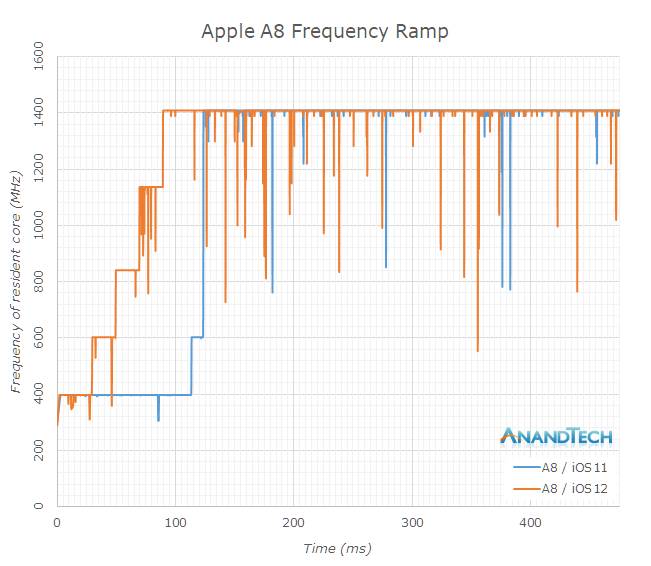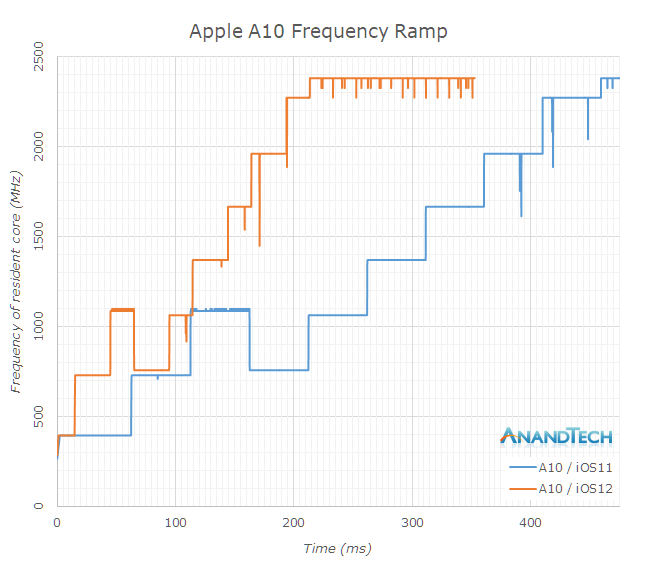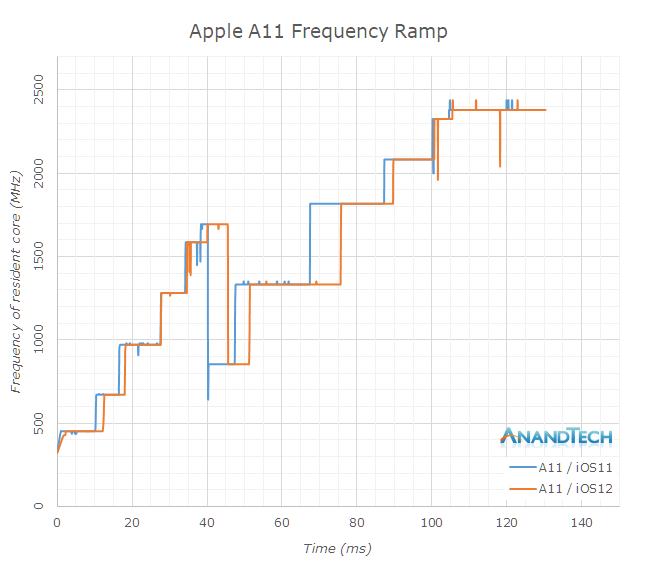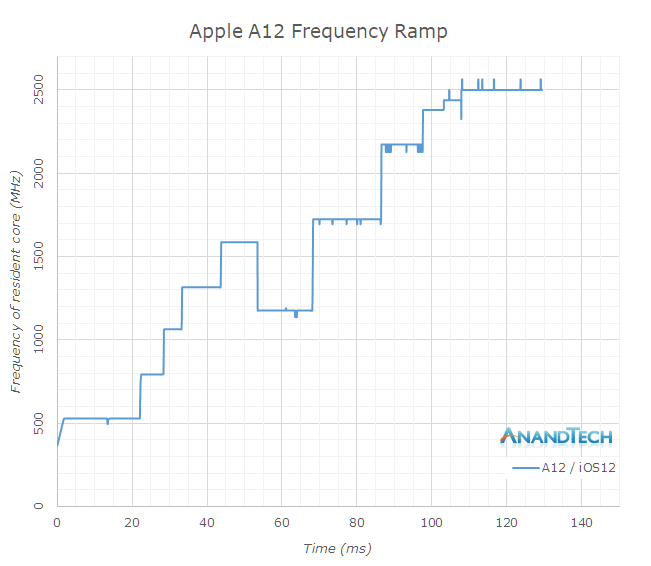The iPhone XS & XS Max Review: Unveiling the Silicon Secrets
by Andrei Frumusanu on October 5, 2018 8:00 AM EST- Posted in
- Mobile
- Apple
- Smartphones
- iPhone XS
- iPhone XS Max
System Performance
While synthetic test performance is one thing, and hopefully we’ve covered that well with SPEC, interactive performance in real use-cases behaves differently, and here software can play a major role in terms of the perceived performance.
I will openly admit that our iOS system performance suite looks extremely meager: we are only really left with our web browser tests, as iOS is quite lacking in meaningful alternatives such as to PCMark on the Android side.

Speedometer 2.0 is the most up-to-date industry standard JavaScript benchmark which tests the most common and modern JS framework performance.
The A12 sports a massive jump of 31% over the A11, again pointing out that Apple’s advertised performance figures are quite underselling the new chipset.
We’re also seeing a small boost from iOS 12 on the previous generation devices. Here the boost comes not only thanks to an a change in how iOS’s scheduler handles load, but also thanks to further improvements in the ever evolving JS engine that Apple uses.

WebXPRT 3 is also a browser test, however its workloads are more wide-spread and varied, containing also a lot of processing tests. Here the iPhone XS showcases a smaller 11% advantage over the iPhone X.
Former devices here also see a healthy boost in performance, with the iPhone X ticking up from 134 to 147 points, or 10%. The iPhone 7’s A10 sees a larger boost of 33%, something we’ll get into more detail in a little bit.
iOS12 Scheduler Load Ramp Analyzed
Apple promised a significant performance improvement in iOS12, thanks to the way their new scheduler is accounting for the loads from individual tasks. The operating system’s kernel scheduler tracks execution time of threads, and aggregates this into an utilisation metric which is then used by for example the DVFS mechanism. The algorithm which decides on how this load is accounted over time is generally simple a software decision – and it can be tweaked and engineered to whatever a vendor sees fit.
Because iOS’s kernel is closed source, we’re can’t really see what the changes are, however we can measure their effects. A relatively simple way to do this is to track frequency over time in a workload from idle, to full performance. I did this on a set of iPhones ranging from the 6 to the X (and XS), before and after the iOS12 system update.
Starting off with the iPhone 6 with the A8 chipset, I had some odd results on iOS11 as the scaling behaviour from idle to full performance was quite unusual. I repeated this a few times yet it still came up with the same results. The A8’s CPU’s idled at 400MHz, and remained here for 110ms until it jumped to 600MHz and then again 10ms later went on to the full 1400MHz of the cores.
iOS12 showcased a more step-wise behaviour, scaling up earlier and also reaching full performance after 90ms.
The iPhone 6S had a significantly different scaling behaviour on iOS11, and the A9 chip’s DVFS was insanely slow. Here it took a total of 435ms for the CPU to reach its maximum frequency. With the iOS12 update, this time has been massively slashed down to 80ms, giving a great boost to performance in shorter interactive workloads.
I was quite astonished to see just how slow the scheduler was before – this is currently the very same issue that is handicapping Samsung’s Exynos chipsets and maybe other Android SoCs who don’t optimise their schedulers. While the hardware performance might be there, it just doesn’t manifest itself in short interactive workloads because the scheduler load tracking algorithm is just too slow.
The A10 had similar bad characteristics as the A9, with time to full performance well exceeding 400ms. In iOS12, the iPhone 7 slashes this roughly in half, to around 210ms. It’s odd to see the A10 being more conservative in this regard compared to the A9 – but this might have something to do with the little cores.
In this graph, it’s also notable to see the frequency of the small cores Zephyr cores – they start at 400MHz and peak at 1100MHz. The frequency in the graph goes down back to 758MHz because at this point there was a core switch over to the big cores, which continue their frequency ramp up until maximum performance.
On the Apple A11 – I didn’t see any major changes, and indeed any differences could just be random noise between measuring on the different firmwares. Both in iOS11 and iOS12, the A11 scales to full frequency in about 105ms. Please note the x-axis in this graph is a lot shorter than previous graphs.
Finally on the iPhone XS’s A12 chipset, we can’t measure any pre- and post- update as the phone comes with iOS12 out of the box. Here again we see that it reaches full performance after 108ms, and we see the transition of the tread from the Tempest cores over to the Vortex cores.
Overall, I hope this is the best and clear visual representation of the performance differences that iOS12 brings to older devices.
In terms of the iPhone XS – I haven’t had any issues at all with performance of the phone and it was fast. I have to admit I’m still a daily Android user, and I use my phones with animations completely turned off as I find they get in the way of the speed of a device. There’s no way to completely turn animation off in iOS, and while this is just my subjective personal opinion, I found they are quite hampering the true performance of the phone. In workloads that are not interactive, the iPhone XS just blazed through them without any issue or concern.















253 Comments
View All Comments
EnzoFX - Friday, October 5, 2018 - link
I switched. Long time nexus user and I feel Google letting the value orientated base behind. It took me saying screw it and paying more for sure, but it has been worth it. Hardware I found lacking and software too since they went t Pixel. Sure on paper it sounded great or fine, but issue after issue would creep up. I never had that many problems with iOS but I feel it's mature enough coming from someone that likes to change settings. The X sold it for me too hardware wise. It was where I saw things going years ago and glad that it's here. (waiting on the Max now however, as I want the real estate!)RSAUser - Saturday, October 6, 2018 - link
Android just doesn't have direct CPU optimization for latency with scrolling.That said, look at phones with Android 8+, that "issue" is pretty much fixed.
For me, most past iOS7 is not really smooth scroll anymore, was one of the first things I noticed back then. There were dropped frames. You'd probably blame hardware though as it was sorted when upgrading to an iPad Air later. Still not a fan of a lot of the UI changes in 11 tbh
tipoo - Thursday, October 18, 2018 - link
I complained about frame drops from iOS7-11, often to crowds of people who would just deny it and say I was seeing things, but Apple addressed it in a WWDC talk and it's much much better in iOS12.I can still notice a frame drop here and there if I'm being picky, but it's vastly improved, I'm guessing 1 frame drop to every 10 on iOS11.
tipoo - Thursday, October 18, 2018 - link
Since the Pixel 1 it felt pretty well as tight as my iPhone on keeping up with my finger imo (though 120hz touch sensing iPhones may have pulled ahead again).id4andrei - Friday, October 5, 2018 - link
So the A12 is basically a Skylake. Also on Anandtech I read that the first ipad pro was almost a Broadwell(like on the 12" MB). Makes sense. A-series powered macbooks surely are in the future.Color management system is again what puts ios above android. Samsung tries with color profiles but it's not a solution. Google fails its ecosystem yet again. Also OpenCL is a mess, no wonder Apple dropped it. It's unreasonable for you to expect Google to throw its weight around it.
The only thing better than A12 is this review. Absolutely SMASHING review Andrei! Your SoC analysis in particular, off the charts awesome; way more descriptive than lowly Geekbench.
tipoo - Thursday, October 18, 2018 - link
Problem then is Google just has no good GPGPU toolchain if they don't get behind OpenCL. What else is there?They did try Renderscript to limited uptake.
tecsi - Friday, October 5, 2018 - link
Andrei,Great work, and a welcome surprise to see these thorough AnandTech reviews return.
I found the photo and video discussions particularly informative and compelling.
Thanks so much for all your hard work and detailed analysis.
Barry
tecsi - Friday, October 5, 2018 - link
Andrei, could you expand on a few camera issues:- Is it correct that the wider video color range is ONLY at 30fps? Why would this be?
- I have always videoed at 60fps, finding 30fps very noticeable with much movement. If this is correct, it seems like this 30fps color improvement only works in a limited number of situations, with very little movement
- Given the A12 performance, why can’t Apple have 480fps or 960fps SloMo like Samsung?
- Finally, with the Neural Engine, will Apple potentially be able to improve the camera system by re-programming this?
Thanks, Barry
Andrei Frumusanu - Friday, October 5, 2018 - link
> - Is it correct that the wider video color range is ONLY at 30fps?Probably the sensor only works at a certain speed and the HDR works by processing multiple frames. Btw, it's wider dynamic range, not colour range.
> Given the A12 performance, why can’t Apple have 480fps or 960fps SloMo like Samsung?
Likely the sensor might be missing dedicated on-module DRAM - which seems to be a requirement for those high framerates.
> - Finally, with the Neural Engine, will Apple potentially be able to improve the camera system by re-programming this?
They can improve the camera characteristics (choice of exposure, ISO, etc) but I find it unlikely they'll get into things that actively improve image quality - that's something next-gen.
s.yu - Monday, October 8, 2018 - link
The on-module DRAM reduces SNR, AFAIK.